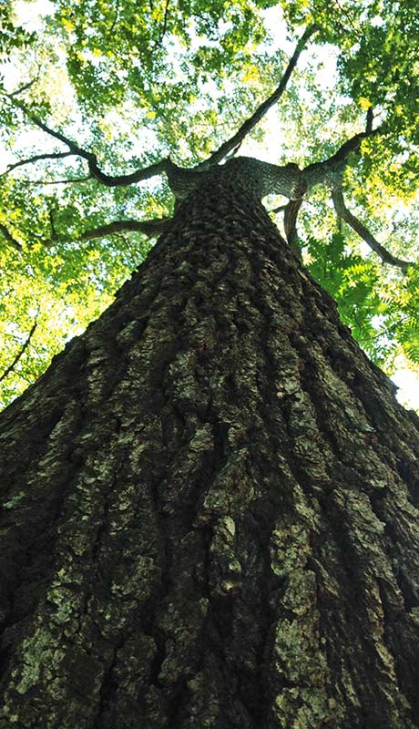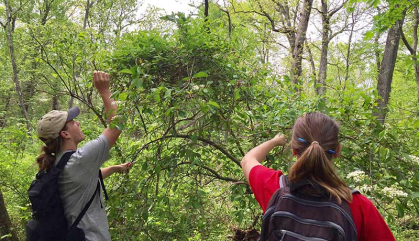Mettler’s Woods Brought Under Additional Protection of National Organization

Rutgers-managed forest is a “sanctuary of biodiversity”
Mettler’s Woods, one of the state’s last remaining virgin forests that sits in a 65-acre patch of land owned and managed by Rutgers University-New Brunswick, has been chosen for preservation by a national organization.
The Old-Growth Forest Network inducted Mettler’s Woods in Franklin in Somerset County, N.J., on Monday, Nov. 18, during a ceremony held on site under a canopy of trees, some of which have stood since the Revolutionary War. The network – which is dedicated to connecting people with nature by creating a national web of protected, mature, publicly accessible native forests – recognized the university’s preservation efforts.

This 300-year-old red oak stands tall over Mettler’s Woods. Oaks are a keystone species in northeastern forests, supporting hundreds of species of insects, birds, and mammals.
“In our rapidly changing world, and especially in densely populated New Jersey, having an old-growth forest in our backyard is rare and invaluable – both for the conservation of biodiversity but also for people to be able to experience a completely different ecosystem that is almost extinct,” said Myla Aronson, an assistant professor in the Department of Ecology, Evolution and Natural Resources in the Rutgers School of Environmental and Biological Sciences.
Aronson also serves as the director of the William L. Hutcheson Memorial Forest Center, a 500-acre preserve that encompasses Mettler’s Woods.
Representatives of the Old-Growth Forest Network ensure the member forests’ protection from logging and inform nature lovers of a forest’s location.
“We are grateful for Rutgers University’s work to protect and study this rare forest,” Brian Kane, Mid-Atlantic manager of the Old-Growth Forest Network, said at the ceremony. “A guided visit to this remarkable forest will allow people to appreciate its remarkable age, its beneficial qualities and its role in a healthy regional ecology.”
Members of the network aim to preserve at least one forest in every forested county in the U.S. Founded in 2012, the network currently includes more than 270 old growth forests in 39 states.

Mettler’s Woods is one of three patches of virgin woods remaining in New Jersey, and one of the last uncut, unburned oak-hickory forests in the country, Aronson said. It is a National Natural Landmark and is managed by the university’s Department of Ecology, Evolution and Natural Resources.
“Mettler’s Woods is special because it is one of the only places left that represents what a forest would have looked like and how it would have functioned before Europeans settled in the area hundreds of years ago,” said Aronson, whose research focuses on the conservation and restoration of biodiversity in human-dominated landscapes. “These woods also have taught us an incredible amount about forest ecology and forest dynamics, from how invasive plant species impact regeneration of the forest to the influence of overabundant deer.”
During the ceremony, Aronson referred to the woods as a “sanctuary of biodiversity.” The area supports hundreds of species of plants and birds, and thousands of species of beneficial insects and soil microbes. Wildflowers carpet the forest floor in the spring, protected by a canopy of 300-year-old red, white and black oaks, along with hickory, American beech and maple trees.

The Hutcheson Memorial Forest Center and Mettler’s Woods have fostered research and education since the 1940s through the present day. Rutgers students (from left) Casey McArdle and Emily Conway examine the effects of non-native Japanese Honeysuckle on a native Blackhaw shrub.
The forest is managed as a living laboratory. The woods and larger preserve around it have been the source of numerous student research projects on birds, bats, bees, soil microbes and plants, including undergraduate theses, graduate dissertations and projects by graduate students and postdoctoral associates from dozens of U.S. and international universities. Undergraduates conduct research in the woods each summer as part of a Forest Stewards Internship program.
Aronson and her students are conducting three major research projects at Mettler’s Woods. They are studying how the forest has changed over time; how long-term populations of invasive plant species impact the growth of tree seedlings and wildflower populations; and whether trees better adapted to warmer temperatures should be used in restoration activities to counter the effects of climate change.
Mettler’s Woods has enchanted Aronson, the scientist, since she was a graduate student. “I remember being instantly taken by the size of the large trees and the beauty of the forest,” she said. “It was spring, so the spring wildflowers were in bloom – mayapple, spring beauty, trout lily. I loved the idea that the trees were older than our country, that they were around for the American Revolution. One feels stability and peace when looking up the trunk of a 300-plus-year-old tree.”


